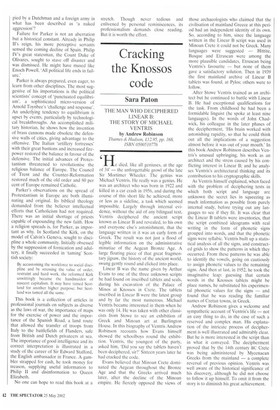Cracking the Knossos code
Sara Paton
THE MAN WHO DECIPHERED LINEAR B: THE STORY OF MICHAEL VENTRIS by Andrew Robinson Thames & Hudson, £12.95, pp. 168, ISBN 0500510776 CHe died, like all geniuses, at the age of 34' — the unforgettable growl of the late Sir Mortimer Wheeler. The genius was Michael Ventris. He really was a genius. He was an architect who was born in 1922 and killed in a car crash in 1956, and during the course of this short life he achieved, more or less as a sideline, a task which seemed impossible. Largely through internal evidence, without the aid of any bilingual text, Ventris deciphered the ancient script known as Linear B and revealed, to his own and everyone else's astonishment, that the language written in it was an early form of Greek. The result was not just a flood of legible information on the administrative minutiae of the Aegean Bronze Age. A large floating piece of that great fragmentary jigsaw, the history of the ancient world, swung gently round and clicked into place.
Linear B was the name given by Arthur Evans to one of the three unknown scripts he had found on inscribed tablets and seals, during his excavation of the Palace of Minos at Knossos in Crete. The tablets inscribed in Linear B were the latest group and by far the most numerous. Michael Ventris became interested in them when he was only 14. He was taken with other classicists from Stowe to see an exhibition of Greek and Minoan art at Burlington House. In this biography of Ventris Andrew Robinson recounts how Evans himself showed the schoolboys round the exhibition. Ventris, the youngest of the party, asked him, Did you say the tablets haven't been deciphered. sir?' Sixteen years later he had cracked the code.
Evans believed that Minoan Crete dominated the Aegean throughout the Bronze Age and that the Greeks arrived much later, after the decline of the Minoan empire. He fiercely opposed the views of those archaeologists who claimed that the civilisation of mainland Greece at this period had an independent identity of its own. So, according to him, since the language written in the Linear B script was used in Minoan Crete it could not be Greek. Many languages were suggested — Hittite, Basque and Etruscan were among the more plausible candidates, Etruscan being Ventris's favourite — but none of them gave a satisfactory solution. Then in 1939 the first mainland archive of Linear B tablets was found, at Pylos; others were to follow.
After Stowe Ventris trained as an architect but he continued to battle with Linear B. He had exceptional qualifications for the task. From childhood he had been a formidable linguist (he spoke at least nine languages). In the words of John Chadwick, his colleague in the later phases of the decipherment, 'His brain worked with astonishing rapidity, so that he could think out all the implications of a suggestion almost before it was out of your mouth.' In this book Andrew Robinson describes Ventris's unusual upbringing, his work as an architect and the stress caused by his conflicting interest in Linear B; and he analyses Ventris's architectural thinking and its contribution to his cryptographic skills.
As Ventris himself explained, when faced with the problem of deciphering texts in which both script and language are unknown the secret lies in squeezing as much information as possible from purely internal study, before trying out any languages to see if they fit. It was clear that the Linear B tablets were inventories, that the script combined ideograms with real writing in the form of phonetic signs grouped into words, and that the phonetic signs were syllabic. Ventris built up a statistical analysis of all the signs, and constructed grids to show the patterns in which they occurred. From these patterns he was able to identify the vowels, going on cautiously to assign phonetic values to the remaining signs. And then at last, in 1952, he took the imaginative leap: guessing that certain words in the Knossos tablets might be place names, he substituted his experimental phonetic values for the signs — and found that he was reading the familiar names of Cretan towns, in Greek.
Andrew Robinson gives a welcome and sympathetic account of Ventris's life — not an easy thing to do, in the case of such a reserved and complex man. His explanation of the intricate process of decipherment is well illustrated and admirably clear. But he is more interested in the script than in what it conveyed. The decipherment proved that by the 14th century BC Crete was being administered by Mycenaean Greeks from the mainland — a complete reversal of previous opinion. Ventris was well aware of the historical significance of his discovery, although he did not choose to follow it up himself. To omit it from the story is to diminish his great achievement.






















































































 Previous page
Previous page